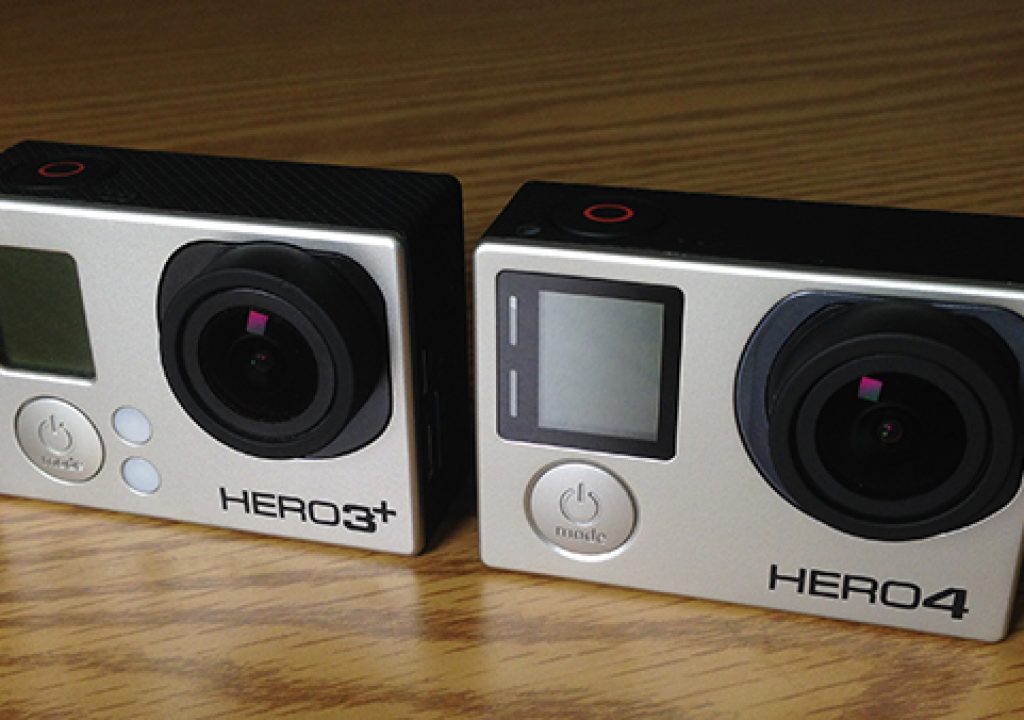Since the announcement of the flagship camera in GoPro’s new HERO4 lineup, I get to give the HERO4 Black a test with several devices and gimbals to see how it compares to the HERO3+ and share my initial results.
By now everyone has seen all the press releases and news about the new GoPro HERO4 camera lineup; including the HERO4 Black and SIlver editions. Yes, the Black gives us 4K @24/30fps and 1080 @120fps, while the Silver is similar to the HERO3+ with the built-in LCD Touch Screen. (I’ll be doing a full-line of HERO4 cameras review as soon as I get them all in for a complete side-by-side comparison and examples in November).
But what I’ve been asked over a hundred times now is “Will the HERO4 Black work in my gimbal?” – The answer is unequivocally, *YES
GoPro HERO4 Black Size, Form and Function
The size, shape and form of the HERO4 Black is nearly identical to the HERO3+ Black, with the exception of the battery placement and the indicator LEDs on the front panel. The weight is slightly higher in the HERO4 than the HERO3+ (88g vs 74g) so if you’re really watching your “weight” for your aerial rig, then take this factor into consideration.
The dimensions are exactly the same across the board for the HERO4 Black, Silver and HERO3+ Black cameras (41x59x30 mm), although the HERO4 Silver weighs slightly less than the Black, coming in at 83g, despite having the built-in LCD Touch Screen. I don’t know if it uses a different battery than the Black yet, but that might account for the weight difference. We’ll see when I get one in to review.
Since the battery now loads in from the bottom of the camera, it may pose some difficulty removing it on some installations if you need to replace it with a freshly-charged battery or need to reboot the camera. However, in most gimbal installations, you have to remove the camera entirely regardless, so this isn’t a big issue.
I’ve also noticed that since the battery is still on the right side of the camera, it doesn’t affect balance at all. In all the gimbals I’ve tested, including the DSLRPros 3-Axis GoPro Stabilizer, it’s a direct fit and works equally as well as the HERO3+. (Note: as soon as I get the HERO4 Silver in to review, I will update to share if the balance is the same as well)
I did some random tests with the HERO4 Black in the stabilizer shooting 4K around our office location near the Bay – and found that it remained well-balanced navigating stairs and pans. Here’s a quick example, though it could be more refined with a steady operator who isn’t amped-up on coffee, I’m sure! <grin>
The HERO4 Black has the following video recording modes, with a 60 Mb/s write (H.264):
- 4K / 30fps
- 2.7K / 50fps
- 1440p / 80fps
- 1080p / 120fps
- 960p / 120fps
- 720p / 120fps
- WVGA / 240fps
I have yet to experiment with the Night Photo/Night Lapse features, but will be shooting and comparing with the HERO4 Silver next month.
Aerial Video Options with the HERO4
The most requested comparison is the DJI Phantom 2 with the H3-3D 3-axis gimbal. I tested the HERO4 Black in my DSLRPros Cannes Cine P2 drone and everything worked perfectly as expected.
In these tests, I included shooting some 4K/30fps footage, as well as some 120fps shots that I could re-time in Adobe Premiere Pro CC, to get a slo-mo effect.
Both of these example videos below show what’s capable with this camera – and I’m really impressed with these results so far.
I’ve also had a chance to do some test flights with the SteadiDrone QU4D quadcopter with the 3DRobotics Pixhawk Autopilot shooting 4K footage and images. While I don’t have a video clip to share just yet, I will be compiling more videos with this drone in an upcoming product review here on my PVC channel. The image at the bottom is from a frame of 4K video I captured around sunset last night. I’m quite impressed with the still frame captures I’ve been getting at 4K/30p.
I will be doing a more structured, full side-by-side comparison in my upcoming HERO4 full-line product review next month once I’ve had some time to test/evaluate all the cameras, so stay tuned!
_____________________________________________________________________________________
Jeff Foster is a published author of several how-to books and training videos in the motion graphics, animation and video production industries and is an award-winning video producer and artist. Visit his web site to learn more about his training methods, tips & tricks at PixelPainter.com

